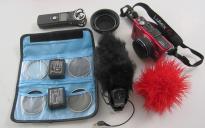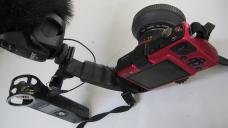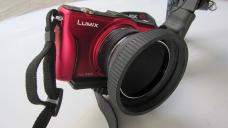
It allows to keep PV going, with more focus towards AI, but keeping be one of the few truly independent places.
-
Having embraced DSLRs after 40 years with a light meter, tape measure and hyper-focal charts, I'd like to try resisting the urge to go backwards and use viewfinder loupes, manual focus and all those things which - after all - really require a team to be done properly.
I see my GH2 with a pancake lens, shooting away while sitting discreetly on a sock-full of rice, or attached to my belt. I've starting to read the manual and find I'm missing out on a lot of what the GH2 can do, automatically, to free me up to work faster and better - not to make a silk purse out of a sow's ear, but to become a more modern videographer.
So, within reason, I'd like to hear from fellow users like me.
[Edit] The stinger, "You don't buy a dog and then go around barking, chasing cars and pissing on trees" is an Australian variation on, You do not get a dog and bark yourself.
-
Not gonna lie, the analogy in the title completely stumped me.
Absurdity notwithstanding, what "modern" alternative do you propose to viewfinder loupes? What's old-fashioned about using them?
And regarding MF / AF, yeah, it's nice that the GH2 supports it in video mode. Works great for a handful of mediocre lenses and only a couple decent ones. In my opinion all of the best glass available today is either manual, or AF made by Canon. To me, compromising on lens quality just to get autofocus would be more backwards than any of the things you seem to take issue with.
-
How to interview and shoot while maintaining eye contact:
Get to know your camera's settings for the situation, get friendly with your talent, then stand with your face about a foot to one side of your camera, engaging the talent visually. A simple pen-laser fixed to the tripod head and pointed at a spot just out-of-frame, at the talent's chest, will guide you as you speak, nod, encourage, and maintain shot with a hand on the tripod lever at your side.
-
Other uses for lasers: line-prisms on 4 lasers ($5 at my hardware store) can be set up to show the exact frame. With steadicam, lets you watch what you're shooting instead of the monitor. Narrative films: shows the talent when they're in-frame, lets a camera operator do a little direction too.
I started using lasers with non-reflex Eyemo 35mm cameras to save money by reducing my shooting ratio to 3:1 instead of the usual 5:1 because of errors. These days I plan to try to save time.
-
Best multiple-focusing hint I've seen for ages is @bheath 's Screen overlay to help with fly-by-wire focus.(please re-name & re-post pic, @bheath)
-
Btw, I saw quite cheap and very accurate laser distance meters.
-
@Roberto would you please care to explain extensively that 4 laser tecnique so I can try it ? I just don´t get it...
-
Imagine experimentally taping 4 laser lights to a fixed lens so that the 4 points of light lie just outside the corners of the frame you see in your viewfinder. Everywhere you point the camera, those 4 dots appear - on the wall, the floor, on the talent's shirt but not in the talent's eyes.
With practice, you can then use the camera without looking through the viewfinder.
Using enough power, the attachment below can even make a line you can see in daylight. So, if you're fussy, four of them (matted to crop sides out if needed) can make a nice, 16:9 rectangle. Everywhere you point you see a rectangle projected.
If you're not fussy, a simple dot on the talent's shirt below bottom centre of frame is easy enough to work with.

 laserLine.png604 x 400 - 400K
laserLine.png604 x 400 - 400K
 laserLine2.png881 x 400 - 439K
laserLine2.png881 x 400 - 439K -
@Sangey There are very good AF lenses out there not made by Canon, e.g. Olympus 4/3 lenses.
The problem is not the lens, but the contrast AF of the GH2, which will allways hunt for focus. The Canons don't hunt for focus, they measure the distance to a subject and calculate the change in focus. Contrast AF is much more flexible, but will always be slower.
I would recommend manual focus over every AF, as you (or your focus puller) know what has to be in focus but the camera is a dumm computer that can only guess;-)
@Roberto The idea with laserpointers is interesting, but I think way to dangerous (especially with the laser in the picture above!). You can really kill ones eyesight with those things. And you don't need to point the laser to there face, a reflective surface (e.g. a wristwatch, spoon,..) is enough to put the beam anywhere in the room...
-
@Psyco you took the words right out of my mouth, using lasers in that fashion can be very dangerous to everyone around you.
-
Yes, it goes without saying that you take no risks. It can be done responsibly but it takes risk management.
(I've worked with pyrotechnics, stunts and camera cars, but by far the biggest risk is a human being).
Class 2
LASER RADIATION DO NOT STARE INTO BEAM CLASS 2 LASER PRODUCT
A Class 2 laser is safe because the blink reflex will limit the exposure to no more than 0.25 seconds. It only applies to visible-light lasers (400–700 nm). Class-2 lasers are limited to 1 mW continuous wave, or more if the emission time is less than 0.25 seconds or if the light is not spatially coherent. Intentional suppression of the blink reflex could lead to eye injury. Many laser pointers and measuring instruments are class 2 http://en.wikipedia.org/wiki/Laser_safety
http://en.wikipedia.org/wiki/Laser_pointer

-
@brianluce Shooting an interview...stop down a bit to get deeper depth of view and tell your subject not to move to much. Or get someone to help behind the camera. You don't need an expert to adjust focus better than the GH2 AF.
@Roberto The problem is much worse. When shooting you might use a lot of light, so your subjet "stares" into bright lights intentionally supressing the blink reflex. They might even see the red glow of the laserbeam, but wouldn't close there eyes. And as the laser only burns a small part of your retina, you don't feel any thing, you just go blind on that spot.
I would just not recomend a laser for that purpose. But I can imagine using your setup for e.g. stop motion animation. Where you have to adjust things in your frame and don't want to walk back and forth a hundret times.
-
Your wariness is understandable and you are right to be cautious. We have all heard stories about laser-pointer injury. When they say safety first they mean without everything being safe we don't go ahead. But we work with a myriad of dangers (from the radically unusual to the commonplace risk of tripping over cables, walking backwards over a kerb..) and they can all be managed.
[Edit May 31] Lasers have been used and improved upon for 50 years now, codes of practices developed - yet some of the myths have persisted.
You can - and should, if you're interested - get training in most aspects of film making. Then if you like, join a professional association and get affordable insurance.
-
I kind of like the assisted focus of the touch screen and I'll have to practice changing focus mid-shot. For that reason I'm reluctant to have any hood or loupe which won't let me get at the screen. The cheap magnetic one will do for now - maybe I'll hang it from the camera on a string. The sun is a big problem with viewfinders for me but a slip-off hood is a blessing.
-
Yes I remember seeing them.. remind me please?
-
I can't find it, my ebay purchase history only goes back 60 days and search function here didn't bring anything up. I know it's a microscope eye cup and is around $28. It works pretty good. You can still open the LCD and it even helps stabilize handheld shots cuz you get another contact point. You can tell it's not a custom fit, but it's close enough and never pops off. Maybe someone remembers the link?
Howdy, Stranger!
It looks like you're new here. If you want to get involved, click one of these buttons!
Categories
- Topics List23,970
- Blog5,724
- General and News1,346
- Hacks and Patches1,153
- ↳ Top Settings33
- ↳ Beginners255
- ↳ Archives402
- ↳ Hacks News and Development56
- Cameras2,360
- ↳ Panasonic990
- ↳ Canon118
- ↳ Sony155
- ↳ Nikon96
- ↳ Pentax and Samsung70
- ↳ Olympus and Fujifilm100
- ↳ Compacts and Camcorders300
- ↳ Smartphones for video97
- ↳ Pro Video Cameras191
- ↳ BlackMagic and other raw cameras117
- Skill1,961
- ↳ Business and distribution66
- ↳ Preparation, scripts and legal38
- ↳ Art149
- ↳ Import, Convert, Exporting291
- ↳ Editors191
- ↳ Effects and stunts115
- ↳ Color grading197
- ↳ Sound and Music280
- ↳ Lighting96
- ↳ Software and storage tips267
- Gear5,414
- ↳ Filters, Adapters, Matte boxes344
- ↳ Lenses1,579
- ↳ Follow focus and gears93
- ↳ Sound498
- ↳ Lighting gear314
- ↳ Camera movement230
- ↳ Gimbals and copters302
- ↳ Rigs and related stuff272
- ↳ Power solutions83
- ↳ Monitors and viewfinders339
- ↳ Tripods and fluid heads139
- ↳ Storage286
- ↳ Computers and studio gear560
- ↳ VR and 3D248
- Showcase1,859
- Marketplace2,834
- Offtopic1,319














